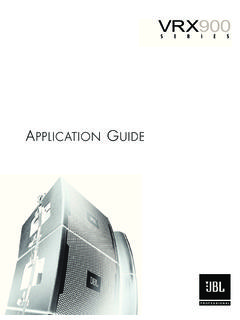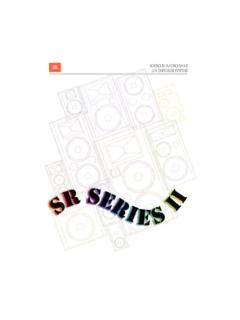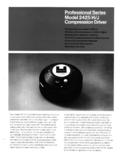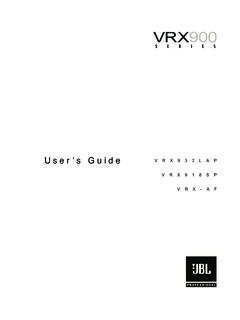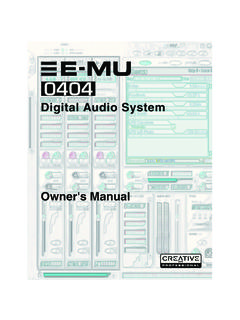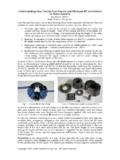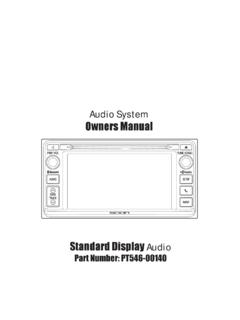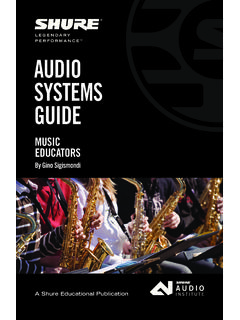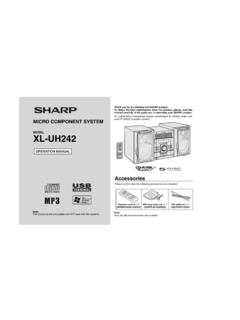Transcription of Sound System Design Reference Manual - JBL Professional
1 Sound System DesignReference ManualSound System Design Reference ManualSound System Design Reference ManualTable of ContentsPreface ..iChapter 1: Wave , Frequency, and Speed of Sound ..1-1 Combining Sine Waves ..1-2 Combining Delayed Sine Waves ..1-3 Diffraction of Sound ..1-5 Effects of Temperature Gradients on Sound Propagation ..1-6 Effects of Wind Velocity and Gradients on Sound Propagation ..1-6 Effect of Humidity on Sound Propagation ..1-7 Chapter 2: The ..2-1 Power Relationships ..2-1 Voltage, Current, and Pressure Relationships ..2-2 Sound Pressure and Loudness Contours ..2-4 Inverse Square Relationships ..2-6 Adding Power Levels in dB ..2-7 Reference Levels ..2-7 Peak, Average, and RMS Signal Values.
2 2-8 Chapter 3: Directivity and Angular Coverage of ..3-1 Some Fundamentals ..3-1A Comparison of Polar Plots, Beamwidth Plots, Directivity Plots, and Isobars ..3-3 Directivity of Circular Radiators ..3-4 The Importance of Flat Power Response ..3-6 Measurement of Directional Characteristics ..3-7 Using Directivity Information ..3-8 Directional Characteristics of Combined Radiators ..3-8 Chapter 4: An Outdoor Sound Reinforcement ..4-1 The Concept of Acoustical Gain ..4-2 The Influence of Directional Microphones and Loudspeakers on System Maximum Gain ..4-3 How Much Gain is Needed? ..4-4 Conclusion ..4-5 Chapter 5: Fundamentals of Room ..5-1 Absorption and Reflection of Sound ..5-1 The Growth and Decay of a Sound Field in a Room.
3 5-5 Reverberation and Reverberation Time ..5-7 Direct and Reverberant Sound Fields ..5-12 Critical Distance ..5-14 The Room Constant ..5-15 Statistical Models and the Real World ..5-20 Sound System Design Reference ManualTable of Contents (cont.)Chapter 6: Behavior of Sound Systems ..6-1 Acoustical Feedback and Potential System Gain ..6-2 Sound Field Calculations for a Small Room ..6-2 Calculations for a Medium-Size Room ..6-5 Calculations for a Distributed Loudspeaker System ..6-8 System Gain vs. Frequency Response ..6-9 The Indoor Gain Equation ..6-9 Measuring Sound System Gain ..6-10 General Requirements for Speech Intelligibility ..6-11 The Role of Time Delay in Sound Reinforcement.
4 6-16 System Equalization and Power Response of Loudspeakers ..6-17 System Design Overview ..6-19 Chapter 7: System Architecture and ..7-1 Typical Signal Flow Diagram ..7-1 Amplifier and Loudspeaker Power Ratings ..7-5 Wire Gauges and Line Losses ..7-5 Constant Voltage Distribution Systems (70-volt lines) ..7-6 Low Frequency Augmentation Subwoofers ..7-6 Case Study A: A Speech and Music System for a Large Evangelical Church ..7-9 Case Study B: A Distributed Sound Reinforcement System for a Large Liturgical Church ..7-12 Case Study C: Specifications for a Distributed Sound System Comprising a Ballroom,Small Meeting Space, and Social/Bar Area ..7-16 BibliographySound System Design Reference ManualPreface to the 1999 Edition:This third edition of JBL Professional s Sound System Design Reference Manual is presented in a newgraphic format that makes for easier reading and study.
5 Like its predecessors, it presents in virtually theiroriginal 1977 form George Augspurger s intuitive and illuminating explanations of Sound and Sound systembehavior in enclosed spaces. The section on systems and case studies has been expanded, and referencesto JBL components have been fundamentals of acoustics and Sound System Design do not change, but System implementationimproves in its effectiveness with ongoing developments in signal processing, transducer refinement, andfront-end flexibility in signal routing and stated in the Preface to the 1986 edition: The technical competence of Professional dealers andsound contractors is much higher today than it was when the Sound Workshop Manual was originallyintroduced.
6 It is JBL s feeling that the serious contractor or Professional dealer of today is ready to move awayfrom simply plugging numbers into equations. Instead, the designer is eager to learn what the equations reallymean, and is intent on learning how loudspeakers and rooms interact, however complex that may be. It is forthe student with such an outlook that this Manual is EargleJanuary 1999iSound System Design Reference ManualSound System Design Reference ManualWavelength, Frequency, and Speed ofSoundSound waves travel approximately 344 m/sec(1130 ft/sec) in air. There is a relatively small velocitydependence on temperature, and under normalindoor conditions we can ignore it. Audible soundcovers the frequency range from about 20 Hz to 20kHz.
7 The wavelength of Sound of a given frequencyis the distance between successive repetitions of thewaveform as the Sound travels through air. It is givenby the following equation:wavelength = speed/frequencyor, using the common abbreviations of c for speed,f for frequency, and l for wavelength:l = c/fPeriod (T) is defined as the time required forone cycle of the waveform. T = 1 f = 1 kHz, T = 1/1000, or sec, andl = 344/1000, or .344 m ( ft.)The lowest audible sounds have wavelengthson the order of 10 m (30 ft), and the highest soundshave wavelengths as short as 20 mm ( in). Therange is quite large, and, as we will see, it has greatbearing on the behavior of waves we have been discussing are ofcourse sine waves, those basic building blocks of allspeech and music signals.
8 Figure 1-1 shows some ofthe basic aspects of sine waves. Note that waves ofthe same frequency can differ in both amplitude andin phase angle. The amplitude and phase anglerelationships between sine waves determine howthey combine, either acoustically or 1: Wave PropagationFigure 1-1. Properties of sine waves1-1 Sound System Design Reference ManualCombining Sine WavesReferring to Figure 1-2, if two or more sinewave signals having the same frequency andamplitude are added, we find that the resulting signalalso has the same frequency and that its amplitudedepends upon the phase relationship of the originalsignals. If there is a phase difference of 120 , theresultant has exactly the same amplitude as eitherof the original signals.
9 If they are combined in phase,the resulting signal has twice the amplitude of eitheroriginal. For phase differences between l20 and240 , the resultant signal always has an amplitudeless than that of either of the original signals. If thetwo signals are exactly 180 out of phase, there willbe total electrical circuits it is difficult to maintainidentical phase relationships between all of the sinecomponents of more complex signals, except for thespecial cases where the signals are combined witha 0 or 180 phase relationship. Circuits whichmaintain some specific phase relationship (45 , forexample) over a wide range of frequencies are fairlycomplex. Such wide range, all-pass phase-shiftingnetworks are used in acoustical signal dealing with complex signals such asmusic or speech, one must understand the conceptof coherence.
10 Suppose we feed an electrical signalthrough a high quality amplifier. Apart from very smallamounts of distortion, the output signal is an exactreplica of the input signal, except for its two signals, although not identical, are said tobe highly coherent. If the signal is passed through apoor amplifier, we can expect substantial differencesbetween input and output, and coherence will not beas great. If we compare totally different signals, anysimilarities occur purely at random, and the two aresaid to be two non-coherent signals are added, therms (root mean square) value of the resulting signalcan be calculated by adding the relative powers ofthe two signals rather than their voltages.
